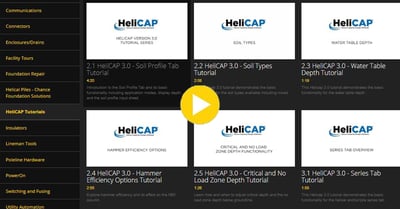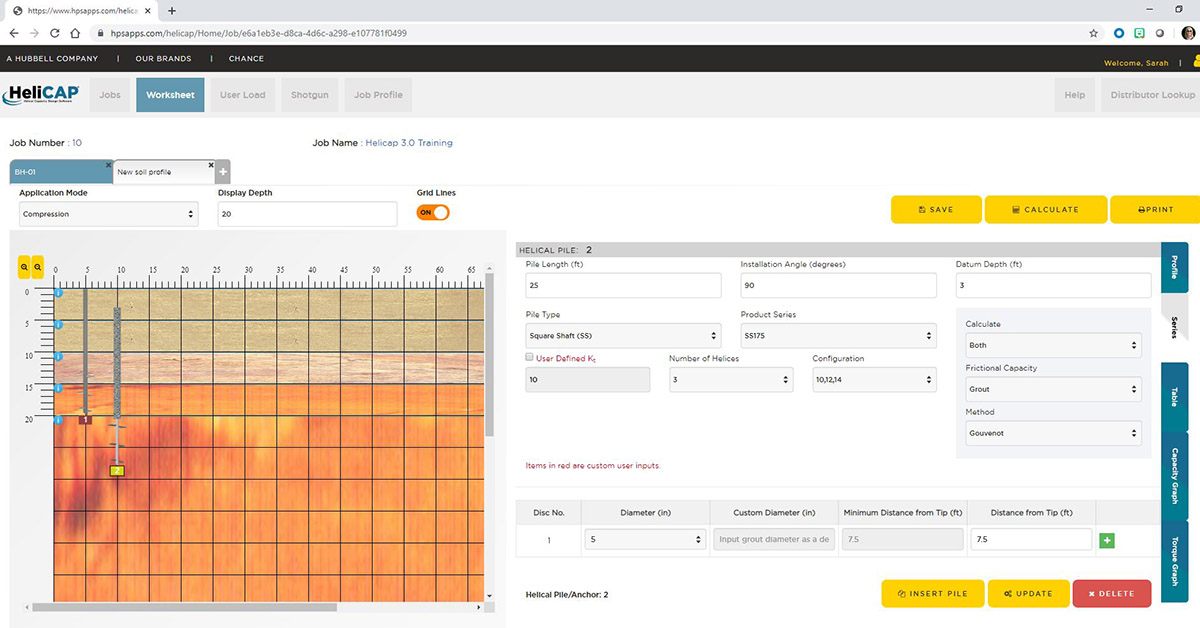 Have you ever needed to estimate the axial capacity of a helical pile? You could calculate helix bearing and shaft friction by hand, but there is a better method. Use HeliCAP® v3.0 Helical Capacity Design Software! HeliCAP is software that estimates the axial capacity of helical piles, is free to use, and accessible from any computer, smartphone, or tablet with an internet connection and a web browser. A desktop or laptop computer with the Google Chrome web browser is recommended for best results.
Have you ever needed to estimate the axial capacity of a helical pile? You could calculate helix bearing and shaft friction by hand, but there is a better method. Use HeliCAP® v3.0 Helical Capacity Design Software! HeliCAP is software that estimates the axial capacity of helical piles, is free to use, and accessible from any computer, smartphone, or tablet with an internet connection and a web browser. A desktop or laptop computer with the Google Chrome web browser is recommended for best results.

Inputs:
To start using HeliCAP, enter soil profile data and one or more helical pile configurations. The soil information can be as basic as the soil type and standard penetration test (SPT) blow count values at depth intervals, or as complete as full laboratory data for shear strength, angle of internal friction, and unit weight. If you enter SPT values per ASTM D1586, HeliCAP estimates the soil properties using typical industry correlations. Pile configuration inputs include shaft size, helix configuration, depth, and installation angle.
Calculations:
HeliCAP typically uses the individual bearing method to estimate helical pile capacity. This method states that the total bearing capacity of the pile is the sum of the individual helix bearing plates (this is valid for inter-helix spacings of at least three times the helix diameter). Using Terzaghi’s equation, HeliCAP calculates the capacity of each helix at its final installation depth and at depths one and two times the helix diameter in the direction of loading (up the shaft for tension and down the shaft for compression). The bearing capacity of each helix is the average of the calculations at the three depths.
The following example illustrates why it is necessary to average calculations at three locations for each helix. If the helix of a pile under compression load is located one inch above the change from a dense soil layer to a soft soil layer and only the calculation at that location is used, the estimated capacity will be erroneously high since it is derived entirely from the properties of the dense soil layer. The helix will shear through the thin remnant of the dense soil layer and "punch" down into the soft soil layer. The actual pile capacity will be much lower than the estimated capacity. HeliCAP uses the average of calculations at three depths to model the pressure bulb that results when load is transferred to the soil by the helix, thereby ensuring that an unexpected punching failure will not occur.
HeliCAP can also calculate the side resistance, or friction capacity, for applicable pile types. It calculates the adhesion/friction on the pile shaft in each soil layer using the Gouvenot or Navy method or a user-defined bond value and sums the soil layer friction capacities. HeliCAP adds the total friction capacity to the total bearing capacity to yield the total estimated pile capacity.
Output:
You can view the HeliCAP calculation results in table or graphical form. The table includes the pile capacity at your input depth, the installation torque required for that depth, the effective torque (the average torque over the last three feet of installation), and pile configuration details. The results graph is a plot of depth vs. capacity throughout the soil profile. The graph is especially useful if the estimated capacity at your input depth is not the target capacity because you can quickly estimate the depth at which the target capacity will be reached.
User Load:
The User Load module in HeliCAP is a handy tool to use if the appropriate pile configuration is in question. You input the pile working load and factor of safety and choose product types and helix configurations of interest, and User Load calculates the shallowest depth for each configuration that attains the required capacity. It also estimates relative cost among the configurations to help choose the most economical configuration.
 How to Get HeliCAP:
How to Get HeliCAP:
Since HeliCAP is cloud-based software, all you need to do to start designing piles is create an account, and log in. A series of tutorial videos is available to answer more specific questions.


